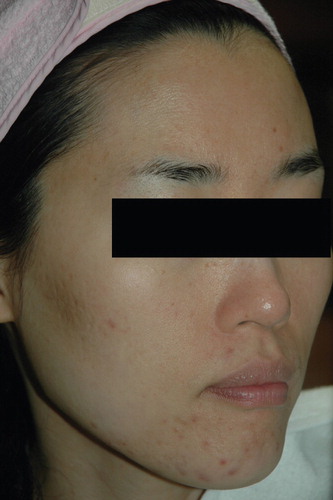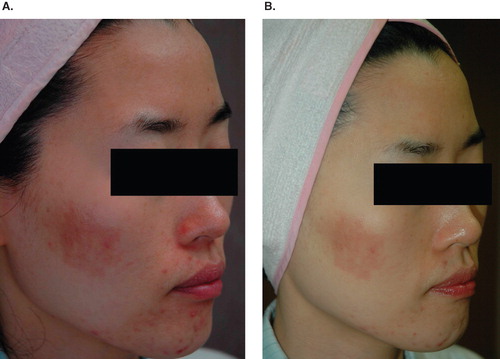Sirs,
A 38-year-old Korean woman with Fitzpatrick skin type IV presented with facial acne and acne scars that had persisted for over 15 years. She had no pertinent medical or family history. Two treatment sessions with a non-ablative 1450-nm diode laser (Smoothbeam™ laser; Candela Corp., Wayland, MA, USA) were performed in our clinic for inflammatory acne on the face using a 6-mm spot size and 14 J/cm2 with a 43-ms cryogen spray duration. Then, to treat erythematous acne lesions, a 595-nm pulsed-dye laser with a dynamic cooling device (V beam™; Candela Corp.) was used.
After improvement of the active acne lesions, she was treated with a 1550-nm erbium-doped fractional photothermolysis system (Fraxel® SR1500™; Reliant Technologies, Mountain View, CA, USA) for acne scars. Prior to the treatment, her entire face was completely cleansed with a skin cleanser. The patient was prescribed oral acyclovir for 3 days as a prophylactic measure. A single treatment using the Fraxel SR1500 with a pulse energy of 40 J/cm2 at level 6 (17% coverage/cm2 per pass) was performed on her entire face. Eight passes were delivered and the treated area became red and puffy within several minutes of the treatment. This reaction subsided within 1 day.
Four weeks after the first Fraxel SR1500 treatment, no noteworthy complications were found (), but clinical improvement was not noticeable either. With a need for more pronounced and faster improvement, a combined treatment with the Fraxel SR1500 and a 10 600-nm Ultrapulse® Encore™ laser (Lumenis Inc., Santa Clara, CA, USA) was delivered. Four passes (half of the first treatment) with the Fraxel SR1500 with a pulse energy of 40 J/cm2 at level 6 were followed by treatment with the Ultrapulse Encore laser in the active FX™ mode with settings of 100 mJ, 75 Hz, density 1 (55% coverage/cm2 per pass), and one pass without overlapping. Immediately after the combined treatment, both cheeks became erythematous and swollen. At 2 and 4 weeks after the treatment, post-therapy erythema and pigmentation were still noted (). Then, V beam™ treatments were delivered with slight improvement of the erythematous lesions. The hyperpigmented lesions were spontaneously, but gradually resolved in 5 months.
Discussion
Treatment with the 1550-nm erbium-doped fractional laser has been proven to deliver effective clinical improvements to photodamaged and scarred skin with a relatively low complication rate (Citation1). The stratum corneum remains intact with the laser treatment, thereby preserving epidermal barrier function. However, it seems that several sessions of treatment must be delivered to achieve a satisfactory level of clinical improvement (Citation1–4).
Ablative laser therapies with CO2 or erbium:YAG lasers are well-accepted treatments for facial rejuvenation and scarring (Citation5). Nevertheless, many dermatologists are reluctant to choose ablative lasers for scar treatment, especially in Asian patients, due to the risk of relatively long downtime, edema, prolonged erythema, post-therapy dyschromias, and scarring (Citation2,Citation3). Conventional ablative CO2 or erbium:YAG lasers can be used more safely by incorporating fractional technology, and the studies describing the efficacy and safety of an ablative 10 600-nm CO2 fractional laser system have been reported (Citation4,Citation6). Chapas et al. (Citation4) demonstrated that only two of 15 patients, treated with three sessions of an ablative 10 600-nm CO2 fractional laser, presented trace or mild post-therapy hyperpigmentation. Also, according to our experience (Citation6), one of 20 Korean patients (all were Fitzpatrick skin types IV) treated with an ablative 10 600-nm CO2 fractional laser for acne scars presented post-therapy hyperpigmentation, which was spontaneously resolved within a month.
In this report, a 1550-nm erbium-doped fractional photothermolysis system and an ablative 10 600-nm CO2 fractional laser were combined with the laser energy delivery reduced to half the usual amount (Citation6), and we observed the occurrence of post-therapy erythema and hyperpigmentation, which persisted over several months. The precise pathogenesis of the post-therapy erythema and hyperpigmentation in our patient could not be elucidated. However, we suggest that these unexpected outcomes may have resulted from bulk heat damage to the surrounding tissues by heat stacking. Although a combined use of 1550-nm erbium-doped and 10 600-nm CO2 fractional lasers can potentially improve clinical outcomes, further studies are necessary to determine the optimal treatment parameters and reduce unexpected adverse reactions.
References
- Graber EM, Tanzi EL, Alster TS. Side effects and complications of fractional laser photothermolysis: Experience with 961 treatments. Dermatol Surg. 2008;34:301–305.
- Hasegawa T, Matsukura T, Mizuno Y, Suga Y, Ogawa H, Ikeda S. Clinical trial of a laser device called fractional photothermolysis system for acne scars. J Dermatol. 2006; 33:623–627.
- Lee HS, Lee JH, Ahn GY, Lee DH, Shin JW, Kim DH, Fractional photothermolysis for the treatment of acne scars: A report of 27 Korean patients. J Dermatolog Treat. 2008; 19:45–49.
- Chapas AM, Brightman L, Sukal S, Hale E, Daniel D, Bernstein LJ, Successful treatment of acneiform scarring with CO2 ablative fractional resurfacing. Lasers Surg Med. 2008; 40:381–386.
- Tay YK, Kwok C. Minimally ablative erbium: YAG laser resurfacing of facial atrophic acne scars in Asian skin: A pilot study. Dermatol Surg. 2008; 34:681–685.
- Cho SB, Lee SJ, Kang JM, The efficacy and safety of 10 600-nm carbon dioxide fractional laser for acne scars in Asian patients. Dermatol Surg. 2009;35:1955–1961.


